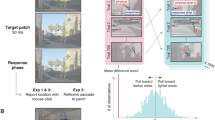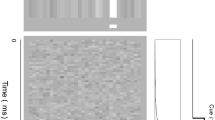Abstract
How long does it take for the human visual system to process a complex natural image? Subjectively, recognition of familiar objects and scenes appears to be virtually instantaneous, but measuring this processing time experimentally has proved difficult. Behavioural measures such as reaction times can be used1, but these include not only visual processing but also the time required for response execution. However, event-related potentials (ERPs) can sometimes reveal signs of neural processing well before the motor output2. Here we use a go/no-go categorization task in which subjects have to decide whether a previously unseen photograph, flashed on for just 20 ms, contains an animal. ERP analysis revealed a frontal negativity specific to no-go trials that develops roughly 150 ms after stimulus onset. We conclude that the visual processing needed to perform this highly demanding task can be achieved in under 150 ms.
This is a preview of subscription content, access via your institution
Access options
Subscription info for Japanese customers
We have a dedicated website for our Japanese customers. Please go to natureasia.com to subscribe to this journal.
Buy this article
- Purchase on SpringerLink
- Instant access to full article PDF
Prices may be subject to local taxes which are calculated during checkout
Similar content being viewed by others
Author information
Authors and Affiliations
Rights and permissions
About this article
Cite this article
Thorpe, S., Fize, D. & Marlot, C. Speed of processing in the human visual system. Nature 381, 520–522 (1996). https://doi.org/10.1038/381520a0
Received:
Accepted:
Issue Date:
DOI: https://doi.org/10.1038/381520a0



